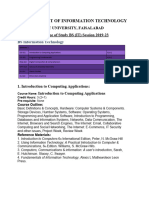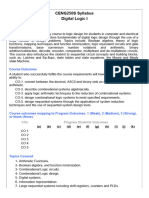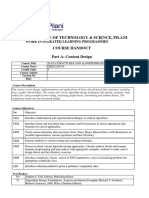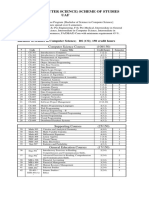0 ratings0% found this document useful (0 votes)
4 viewsLearn Data Science Tutorial - Full Course for Beginners
The document outlines a comprehensive course on Data Science, divided into five parts covering foundational topics such as data sourcing, coding, mathematics, and statistics. Each part includes various subtopics that explore essential concepts and tools used in the field. The course aims to equip learners with the necessary skills and knowledge for effective data analysis and interpretation.
Uploaded by
mehdi labCopyright
© © All Rights Reserved
Available Formats
Download as TXT, PDF, TXT or read online on Scribd
0 ratings0% found this document useful (0 votes)
4 viewsLearn Data Science Tutorial - Full Course for Beginners
The document outlines a comprehensive course on Data Science, divided into five parts covering foundational topics such as data sourcing, coding, mathematics, and statistics. Each part includes various subtopics that explore essential concepts and tools used in the field. The course aims to equip learners with the necessary skills and knowledge for effective data analysis and interpretation.
Uploaded by
mehdi labCopyright
© © All Rights Reserved
Available Formats
Download as TXT, PDF, TXT or read online on Scribd
You are on page 1/ 2
Course Contents
⌨️ Part 1: Data Science: An Introduction: Foundations of Data Science
- Welcome (1.1)
- Demand for Data Science (2.1)
- The Data Science Venn Diagram (2.2)
- The Data Science Pathway (2.3)
- Roles in Data Science (2.4)
- Teams in Data Science (2.5)
- Big Data (3.1)
- Coding (3.2)
- Statistics (3.3)
- Business Intelligence (3.4)
- Do No Harm (4.1)
- Methods Overview (5.1)
- Sourcing Overview (5.2)
- Coding Overview (5.3)
- Math Overview (5.4)
- Statistics Overview (5.5)
- Machine Learning Overview (5.6)
- Interpretability (6.1)
- Actionable Insights (6.2)
- Presentation Graphics (6.3)
- Reproducible Research (6.4)
- Next Steps (7.1)
⌨️ Part 2: Data Sourcing: Foundations of Data Science (1:39:46)
- Welcome (1.1)
- Metrics (2.1)
- Accuracy (2.2)
- Social Context of Measurement (2.3)
- Existing Data (3.1)
- APIs (3.2)
- Scraping (3.3)
- New Data (4.1)
- Interviews (4.2)
- Surveys (4.3)
- Card Sorting (4.4)
- Lab Experiments (4.5)
- A/B Testing (4.6)
- Next Steps (5.1)
⌨️ Part 3: Coding (2:32:42)
- Welcome (1.1)
- Spreadsheets (2.1)
- Tableau Public (2.2)
- SPSS (2.3)
- JASP (2.4)
- Other Software (2.5)
- HTML (3.1)
- XML (3.2)
- JSON (3.3)
- R (4.1)
- Python (4.2)
- SQL (4.3)
- C, C++, & Java (4.4)
- Bash (4.5)
- Regex (5.1)
- Next Steps (6.1)
⌨️ Part 4: Mathematics (4:01:09)
- Welcome (1.1)
- Elementary Algebra (2.1)
- Linear Algebra (2.2)
- Systems of Linear Equations (2.3)
- Calculus (2.4)
- Calculus & Optimization (2.5)
- Big O (3.1)
- Probability (3.2)
⌨️ Part 5: Statistics (4:44:03)
- Welcome (1.1)
- Exploration Overview (2.1)
- Exploratory Graphics (2.2)
- Exploratory Statistics (2.3)
- Descriptive Statistics (2.4)
- Inferential Statistics (3.1)
- Hypothesis Testing (3.2)
- Estimation (3.3)
- Estimators (4.1)
- Measures of Fit (4.2)
- Feature Selection (4.3)
- Problems in Modeling (4.4)
- Model Validation (4.5)
- DIY (4.6)
- Next Step (5.1)
You might also like
- Intelligent Systems: Principles, Paradigms and Pragmatics0% (1)Intelligent Systems: Principles, Paradigms and Pragmatics20 pages
- B.Sc. (H) Computer Science V Semester: 501 - File Structure and Database DesignNo ratings yetB.Sc. (H) Computer Science V Semester: 501 - File Structure and Database Design5 pages
- Download full Visualizing Data in R 4: Graphics Using the base, graphics, stats, and ggplot2 Packages 1st Edition Margot Tollefson ebook all chapters100% (3)Download full Visualizing Data in R 4: Graphics Using the base, graphics, stats, and ggplot2 Packages 1st Edition Margot Tollefson ebook all chapters22 pages
- (Ebook) Visualizing Data in R 4: Graphics Using the base, graphics, stats, and ggplot2 Packages by Margot Tollefson ISBN 9781484268308, 148426830X - The full ebook version is just one click away100% (1)(Ebook) Visualizing Data in R 4: Graphics Using the base, graphics, stats, and ggplot2 Packages by Margot Tollefson ISBN 9781484268308, 148426830X - The full ebook version is just one click away81 pages
- Computerized Payroll System Documentation - 2 PDFNo ratings yetComputerized Payroll System Documentation - 2 PDF82 pages
- Cp7201 Tfoc Lesson Plan Theoretical Foundations of Computer Science100% (3)Cp7201 Tfoc Lesson Plan Theoretical Foundations of Computer Science2 pages
- Scheme of Studies ADP (IT) and BS (IT) 5th, Bridging Program (2022-24)No ratings yetScheme of Studies ADP (IT) and BS (IT) 5th, Bridging Program (2022-24)28 pages
- 5th Grade Formative Assessment Data: Module 1 - Place Value and Decimal FractionsNo ratings yet5th Grade Formative Assessment Data: Module 1 - Place Value and Decimal Fractions6 pages
- Bachelor of Science in Information Technology BS (IT) : 4 Years Program. 150 Credit Hours Spread Over 8 SemestersNo ratings yetBachelor of Science in Information Technology BS (IT) : 4 Years Program. 150 Credit Hours Spread Over 8 Semesters10 pages
- Get (Ebook) Data Visualization and Analysis in Second Language Research by Guilherme D. Garcia ISBN 9780367469610, 0367469618 free all chapters100% (7)Get (Ebook) Data Visualization and Analysis in Second Language Research by Guilherme D. Garcia ISBN 9780367469610, 0367469618 free all chapters55 pages
- Road Map and Outlines BS (CS) 2023-27 (U)No ratings yetRoad Map and Outlines BS (CS) 2023-27 (U)48 pages
- Computer Knowledge - Competative Exams GuideNo ratings yetComputer Knowledge - Competative Exams Guide68 pages
- (ME Computer Science and Engineering) : Structure of Post GraduateNo ratings yet(ME Computer Science and Engineering) : Structure of Post Graduate43 pages
- Syllabus For B. Sc. Computer Science (Hons) Under CBCS W.E.F. The Academic Year 2016-2017No ratings yetSyllabus For B. Sc. Computer Science (Hons) Under CBCS W.E.F. The Academic Year 2016-201726 pages
- Birla Institute of Technology & Science, Pilani: Work Integrated Learning ProgrammesNo ratings yetBirla Institute of Technology & Science, Pilani: Work Integrated Learning Programmes9 pages
- Set of 15 Sample Papers With Solutions & Blueprint For Class 12 IP, 2024-25 Exam EditionNo ratings yetSet of 15 Sample Papers With Solutions & Blueprint For Class 12 IP, 2024-25 Exam Edition142 pages
- 1BSCS Course Outline Revise March 4 2024No ratings yet1BSCS Course Outline Revise March 4 20243 pages
- M.sc.F.Y. Syllabus ComputerScienceRevisedNo ratings yetM.sc.F.Y. Syllabus ComputerScienceRevised17 pages
- CS 202-Data Structures-Dr - Ihsan Ayyub QaziNo ratings yetCS 202-Data Structures-Dr - Ihsan Ayyub Qazi2 pages
- Bs (Computer Science) Scheme of Studies UAFNo ratings yetBs (Computer Science) Scheme of Studies UAF25 pages
- Visualizing Data in R 4: Graphics Using the base, graphics, stats, and ggplot2 Packages 1st Edition Margot Tollefson All Chapters Instant Download100% (1)Visualizing Data in R 4: Graphics Using the base, graphics, stats, and ggplot2 Packages 1st Edition Margot Tollefson All Chapters Instant Download40 pages
- Department of Computer Science & Engineering: National Institute of Technology, Hamirpur (HP) - 177005No ratings yetDepartment of Computer Science & Engineering: National Institute of Technology, Hamirpur (HP) - 17700561 pages
- Introducing Geographic Information Systems with ArcGIS: A Workbook Approach to Learning GISFrom EverandIntroducing Geographic Information Systems with ArcGIS: A Workbook Approach to Learning GIS3/5 (1)
- Math Starters: 5- to 10-Minute Activities Aligned with the Common Core Math Standards, Grades 6-12From EverandMath Starters: 5- to 10-Minute Activities Aligned with the Common Core Math Standards, Grades 6-12No ratings yet
- Foundations of Data Intensive Applications: Large Scale Data Analytics under the HoodFrom EverandFoundations of Data Intensive Applications: Large Scale Data Analytics under the HoodNo ratings yet
- The Art of Machine Learning: A Hands-On Guide to Machine Learning with RFrom EverandThe Art of Machine Learning: A Hands-On Guide to Machine Learning with R5/5 (1)



























































